October is a month of transition here in south Florida. The wet days of the rainy season start to taper off, giving way to the first few cooling breaths of our short-lived autumn, eventually to be followed by the drier and steadier days of our wintertime dry season (which usually arrives around November). That doesn’t mean it won’t rain; we still get appreciable rainfall in this last month of the wet season, but the rains are punctuated by spells of drier, cooler weather, that is much welcomed after the long, hot days of summer.
The first few days this month were typical late summer/early fall, with warm, humid weather. The only thing atypical about it was the lack of easterly breeze, at least in the early hours, making photography relatively easy. On the first weekend of the month, a cool front blew through, lowering the 8 a.m. temps from the high 70s/low 80s to the mid-60s. Yay! It also made photography even easier, pushing the energy budget of the insects down a mite. Whether for that reason or some seasonal effect (late emergence, early migration, what have you), I was able to add a Green Darner (only seen once before in the four years we’ve been on this site) and the two bee species only after the cool front. Whether they were here and I just missed them before the shift in the weather, I don’t know.
These questions mean it’s time to get outside on a bit more regular basis, to attempt to answer them! This year I was particularly motivated to get outside in October, because I recently joined the North American Butterfly Association, after years of telling myself “I really should join NABA.” They’re a nonprofit organization dedicated to education, conservation, and scientific research on—you guessed it!—butterflies! They have a butterfly garden certification program that allows you to send them a brief inventory of the nectar plants (flowers) and larval host plants (caterpillar food) in your yard, along with a check or other payment, and get a lovely sign to post in your yard:
While the certification process is not onerous (seriously—all I had to do was indicate the size of the plot, the management practices, and list three nectar plants and three host plants, no pictures, no records, nothing), it did get me to thinking about taking inventory in the yard in a new way.
So that’s what I did. First, I made a table of all the butterfly plants in my yard (nearly 30 different species!). That done, I decided I needed to do a bit more. So I started another spreadsheet (oh, the joy!) to record my wildlife sightings on a monthly basis. It’s a bit like the yard list that birders do, but like a true geek, I decided that it needed to be a bit more comprehensive, including month and year, rather than just as a checkmark on a bare list.
I went as far back as 2012 in my photo archives to populate the list with a bit of scattershot historical data, but going forward I’ll be updating it as often as I can, and as often as I can get decent pictures. Right now it lists only a couple of insect orders: Odonata (damsel- and dragonflies) and Lepidoptera (butterflies, moths, skippers). As and when I find time I’ll update the lists, at least to include the Hymenoptera (ants, bees, wasps).
This gives me an incentive to get out and see what’s new, who’s more abundant now, who’s absent. And I will no longer have to rely solely on my wretched memory to know when certain species are present or absent, and with what kind of frequency.
As advertised, the first few mornings of October 2014 were lovely—good light, very little wind, not yet hotter than blazes. Over those first few days I’ve documented the following insects and spiders in the garden:
-
- 3 species of damselfly (the usual suspects: two fork tails [Ischnuras ramburii and hastata] and our ever-present Everglades Sprite [Nehalennia pallidula]); here’s a picture of the Rambur’s Forktail from September, but they look the same in October:
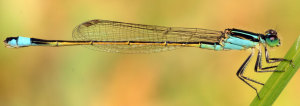
-
- 6 species of dragonfly (Band-winged Dragonlet, Little Blue Dragonlet, Blue Dasher, Carolina Saddlebags, Halloween Pennant, and a new one for the yard, Eastern Amberwing!)
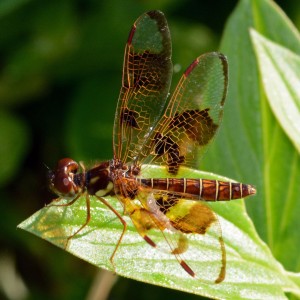
-
- The usual species of butterfly (Zebra Heliconian, Gulf Fritillary, Cassius Blue, Cloudless Sulphur, Giant Swallowtail). Thanks to the cooler weather I was able to get up close and personal with a Cloudless Sulphur butterfly (Phoebis sennae), normally far too swift and fluttery for me to capture on “film.” Yay, cooler weather!
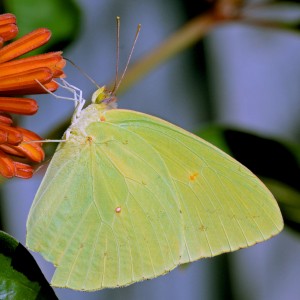
-
- An Ichneumon wasp, genus Anomalon
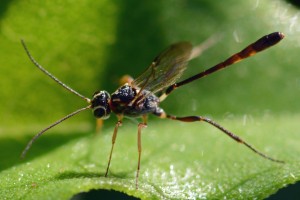
-
-
- The usual quartet of large south Florida garden spiders (Gasteracantha cancriformis, Argiope argentata, A. trifasciata, and Leucauge argyra). Pictured is the very common (elsewhere, rare-ish in my yard) Banded Garden Spider, Argiope trifasciata. The smaller spider on the opposite side of the web from the large female is the small male. He no dummy!
-
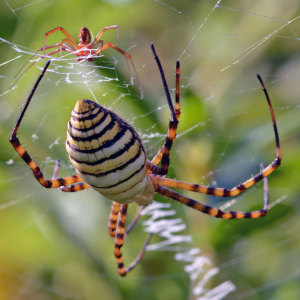
-
- Several syrphid flies (also known as “hoverfly” or “flower fly”): Toxomerus marginatus and T. boscii.
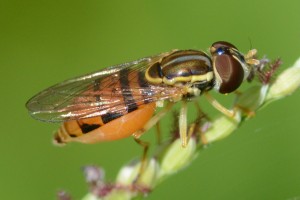
-
-
- A pair of unidentified sarcophagid flies (also called “flesh flies”)
- A “leaf beetle,” Chalepus sanguinicollis:
-
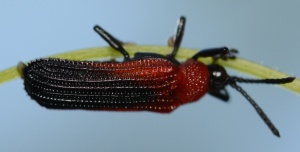
-
- One of our two yard-normal halictids (sweat bees), Halictus poeyi
- A leaf-cutter (megachilid) bee, Megachile petulans, demonstrating a very stout abdomen and a tiny waist more reminiscent of a wasp than a bee—looks a bit like a little grenade or something! It also has a very loud buzz; much more noticeable than the sweat bees or honeybees that cruise through here most of the time:
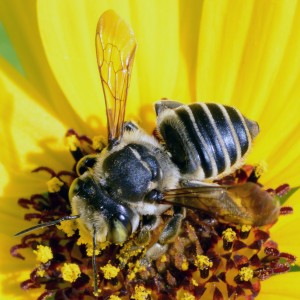
I don’t know whether this data will ever be useful to anyone, but it’s a fun project. And when you find a new species for your yard, it can be really exciting. Getting a reasonable picture of one of those tiny little flower flies (T. marginatus in this case) encouraged me to comb through my past photos to get a few more IDs from the good folks at bugguide.net.
So I guess it’s misleading to call this an “inventory”; for now it’s more of a snapshot, taken from the limited perspective of a few short hours in the “field.” Nevertheless, it’s an interesting snapshot. Speaking of which, hope you enjoyed these snapshots of the insect and arachnid life in a small suburban yard in south Florida!
You never know what you mind find when you get out into nature—even if it’s only right outside your door.
Next up: the second half of the month, including a new butterfly species for the yard, Martial Scrub-Hairstreak (with photos) and the return of the hummingbirds (without photos).

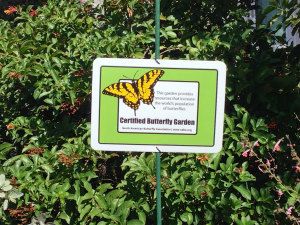
The fly in the photo you have labelled as Toxomerus marginatus (common name: Margined Calligrapher) does not appear to have the distinctive pale margin on its abdomen that this species should have. Since it is in Florida, where there are several similar species, I think it is probably one of those such as T. floralis or T. dispar and not T. marginatus.
However, I encourage you to post it on an identification website such as https://bugguide.net or http://inaturalist.org to confirm.
Thanks for the help ruling out T. marginatus; it sounds like that specific name actually refers to the pale margin you’re talking about (which I’d never known before)! I’ve updated to Toxomerus sp. here. I had posted another photo of the same individual to bugguide.net, but that was a view from the top that didn’t show the sides of the abdomen like this one. And it was tentatively ID’ed as T. marginatus. I’m sure, had I posted this side view, that the ID would have been Toxomerus sp. instead.